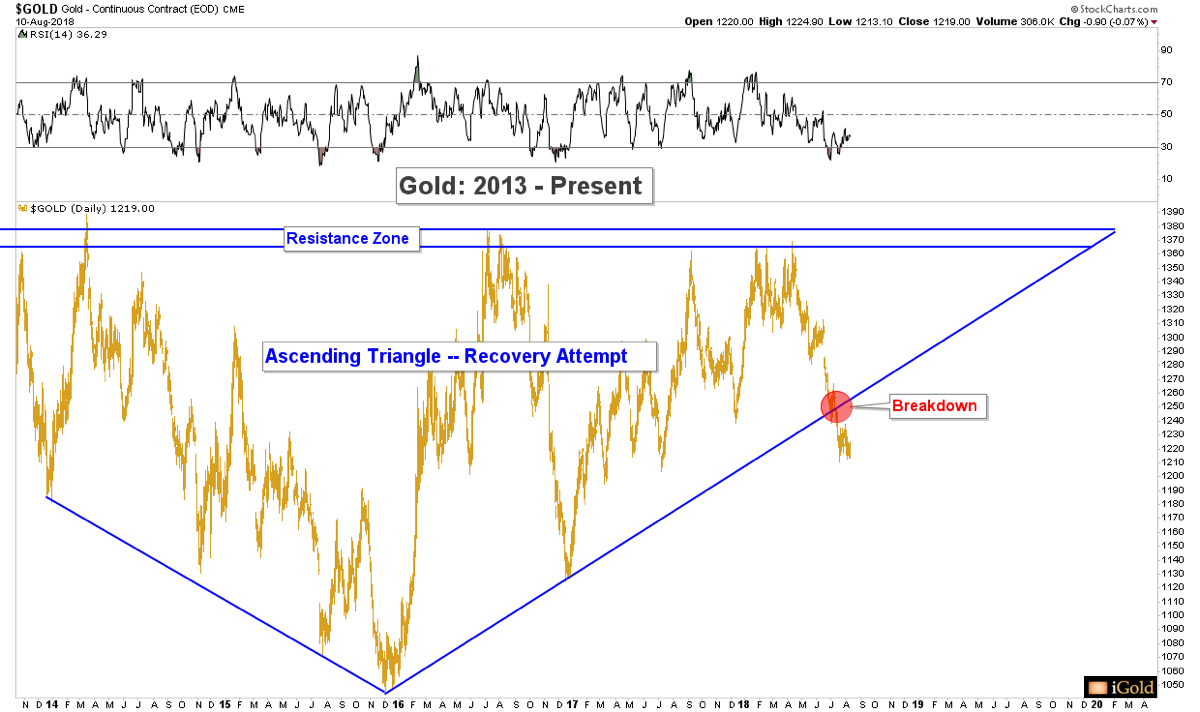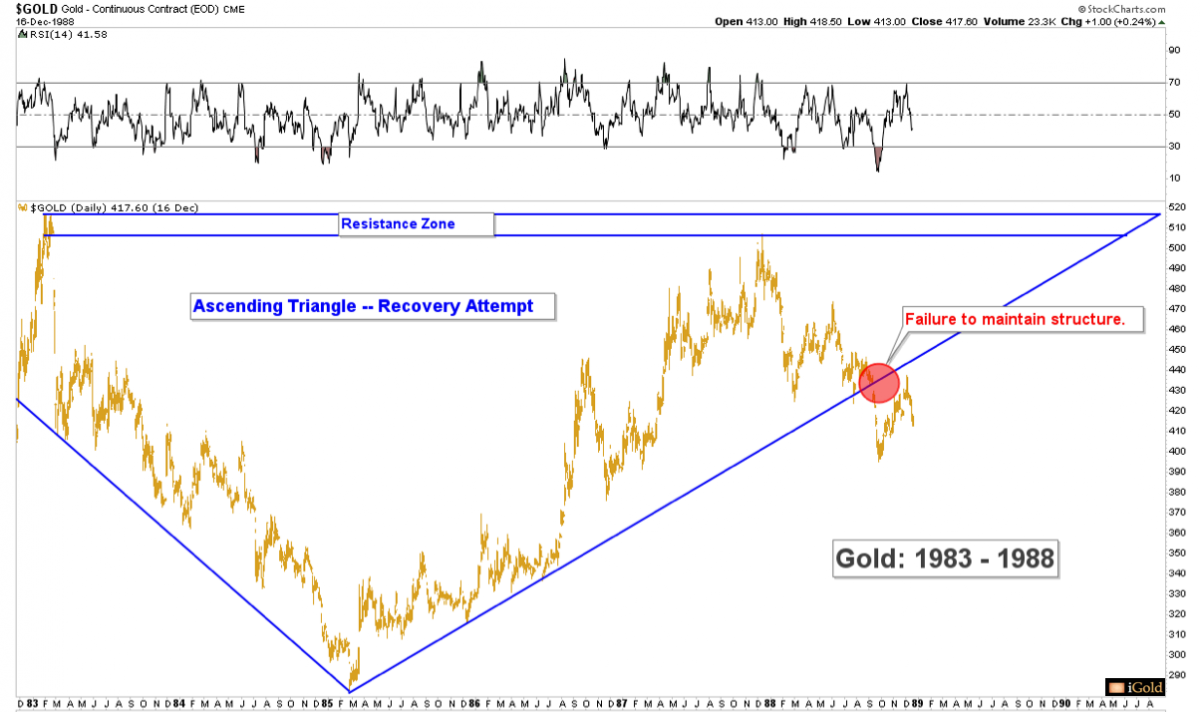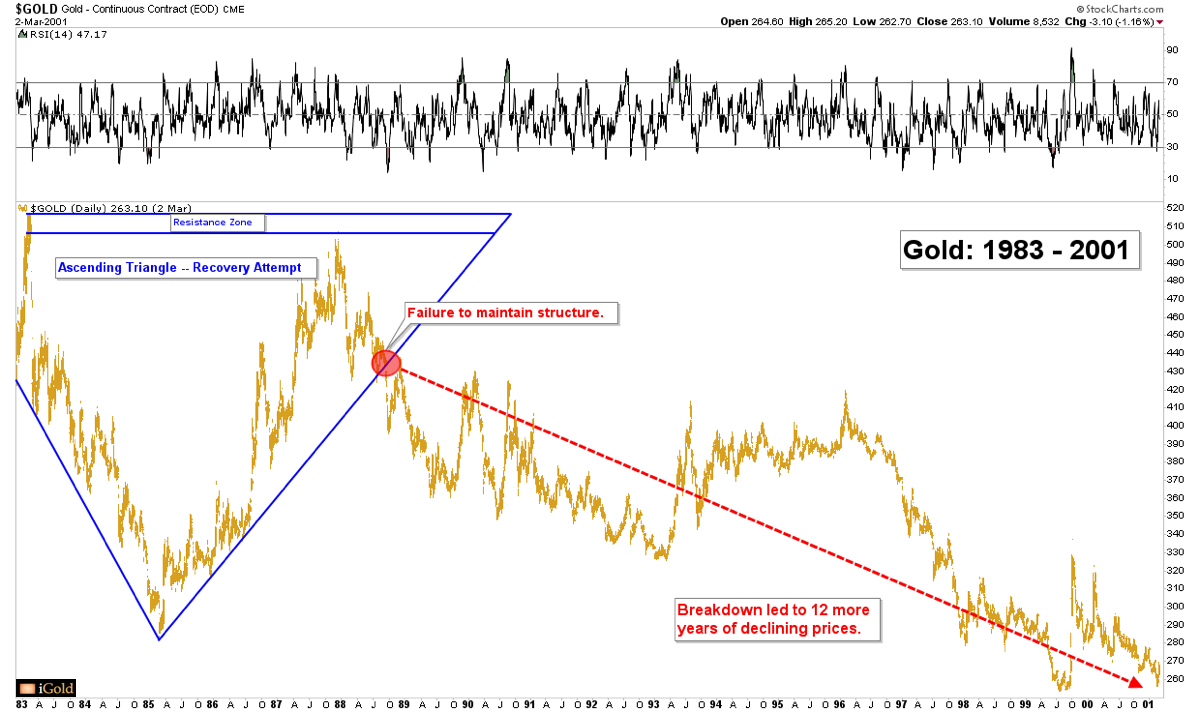Gold Price Forecast: Recovery Attempt Has Failed

Gold’s bottoming attempt following the 2015 low of $1,045 per ounce has failed to maintain a price structure indicative of a rising trend. Consequently, the odds have now shifted significantly that precious metals will not be in a bull market for the foreseeable future. This does not mean that the price of gold is going to crash, nor that an investment in the precious metals sector may not be wise given one’s unique situation. However, with the recent trend failure the highest-probability is that the 2016 peak of $1,378 per ounce will not be overcome for gold for at least the next several years.
Let us examine the current price trajectory and some ramifications.
Gold’s Price Structure Breaks Down
Gold’s attempted recovery from the 2015 bottom has failed to maintain a healthy price structure. First, examine the chart below:
Primary market advances can take many forms, but there are certain warning signals which emerge over and over again throughout history which can alert us to the health or lack thereof within a market.
For example, if a market is set to emerge from a long-term bottom pattern, a series of higher lows should be observed. This trend of higher prices may be slow to build, and twists and turns may develop along the way. However, the takeaway is that when a market is forming a long-term bottom, rising prices should be observed throughout time, as buyers step in at higher and higher intervals, not wanting to wait for gold to fall before adding to positions.
This is what should constitute a healthy bottoming process and the emergence of a primary rising trend.
Again, note above (red callout) that gold’s rising structure has been negated. What are the ramifications now that the trend has broken?
Market Lessons From History
Let us examine what happens when a market fails to maintain its proper structure during a potential long-term bottom. Below is the example from 1983 – 1987, in which gold fell from $500 to $290 and then attempted to recover over the course of these years:
Note how in 1988 after peaking at $500 per ounce the prior year, gold failed to eclipse its former 1983 peak.
The gold market then broke its series of higher lows which had held since the 1985 bottom. The break of the series of higher lows was a key turning point to alert investors that the bottoming attempt was failing: a healthy market should not see declining lows throughout time.
What was the result following gold’s failure to maintain an advancing structure? Let us fast forward the above chart by 12 more years:
Notice how after breaking its structure, gold was unable to recover the $500 region, and indeed continued to grind lower for 12 more years.
Was this 12-year period a good time to be accumulating gold as “wealth insurance”? Surely.
But was this a smart time to be over-exposed in leveraged accounts (ETF’s did not exist back then), margin debt, or the gold mining sector? Certainly not.
Back To The Present
Refer again to the first chart in this article.
Note the similarity of the present pattern to the 1983 – 1988 example, as gold had moved downward into 2015 followed by a nearly symmetrical recovery attempt. Note additionally that gold has clearly broken down from its recovery pattern by the failure observed two weeks ago at $1,245 per ounce. This is a similar structural negation as occurred in 1987 at the $450 price level shown above.
Again, in 1987 this structural breakdown preceded 12 more years of declining prices.
What Now For Gold?
Is gold going to decline for 12 more years now, similar to the 1987 example?
Of course, it is too early to say.
Over the short run, the present decline is over-extended. Gold has moved lower in nearly a straight line since the April peak at $1,366. Ergo, a recovery is likely due back to $1,250 - $1,260 over the next several weeks.
Minor support for gold is now being seen in the $1,205 region, and stronger support exists at $1,125, corresponding with the bottom from December 2016.
The larger point remains: gold has failed to uphold the integrity of its rising structure, and so we should not expect a skyrocket in prices anytime soon. Gold will have work to do ahead of itself in order to build a longer and healthier base and to attempt to round upward again.
This may or may not be a welcomed development, depending on one’s unique situation. Those who see gold as a long-term store of value or “wealth insurance” policy may welcome the opportunity to continue accumulating the metal at lower prices. The best time to purchase insurance is, of course, is before it is needed.
However, those over-exposed to leveraged forms of investment within the precious metals sector should be cautious over the intermediate term: a short-term bottom is due, but over the next 12 – 24 months lower prices should be expected.
In the next series of articles, we will dive deeper into the long-term model, which will help us to assess probabilities for the next significant bottom when it occurs in the gold market.
*********





















